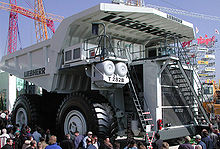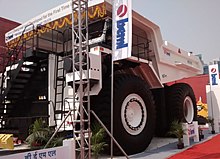Haul truck

Haul trucks are off-highway, rigid dump trucks specifically engineered for use in high-production mining and heavy-duty construction environments. Haul trucks are also used for transporting construction equipment from job site to job site. Some are multi-axle in order to support the equipment that is being hauled.
Description[]
Most haul trucks have a two-axle design, but two well-known models from the 1970s, the 350T Terex Titan and 235T Wabco 3200/B, had three axles. [1] Haul truck capacities range from 40 short tons (36 long tons; 36 t) to 496 short tons (443 long tons; 450 t).
Large quarry-sized trucks range from 40 to 100 short tons (36 to 89 long tons; 36 to 91 t). A good example of this is the Caterpillar 775 (rated at 70 short tons [62 long tons; 64 t]).[2] Quarry operations are typically smaller than, say, a gold/copper mine, and require smaller trucks.
Ultra class[]

The largest, highest-payload-capacity haul trucks are referred to as ultra class trucks. The ultra class includes all haul trucks with a payload capacity of 300 short tons (270 long tons; 270 t) or greater.[3] As of October 2013, the BelAZ 75710 has the highest payload capacity, 450 metric tons (440 long tons; 500 short tons).[4]
Rear-eject[]

A rear-eject configuration is an alternative haul truck body style. Instead of lifting the bed vertically, the hydraulic cylinder pushes a ram-face horizontally through the body to eject the hauled load.[5]
Rear-eject dump vehicles were first introduced in the 1980s by LeRoy Hagenbuch, P.E. of Philippi-Hagenbuch, Inc.,[6] for a refuse hauling application in New York City. They were designed to work on Volvo BM truck chassis. While the functionality of the ejector bodies worked well, they were prone to maintenance issues and not replicated until the 1990s.[citation needed] The next documented ejector bodies were developed by DDT, a UK truck manufacturer.[7] A variation using steel chains instead of a hydraulic ram was introduced by , but did not become popular.[8]
Caterpillar Inc. began offering a rear-eject option using technology originally designed for its scrapers after one of its contractors successfully converted a few CAT D400 models. The new design, installed on the company's D400E model, was less likely to jam in cold weather.[8] CAT later began manufacturing a standard R.E. body for its 730, 740, and 740B articulating haul-truck series.[9]
, a company specializing in truck body design, developed its own mechanism for its rear-eject bodies, and has patented its design in the US, Europe and Australia.[5] The company customizes Rear-Eject bodies or trailers for several manufacturers' off-highway vehicles; including both rigid and articulating varieties.[10]
As of 2014 Caterpillar Inc. and Philippi-Hagenbuch, Inc. are continuing to manufacture Rear-Eject bodies for off-highway applications,[5] each using its own design of mechanism.
Rear-eject vs. end-dump[]
Because rear-eject bodies do not lift, or move externally in any way, they maintain a lower center of gravity. This means more stability on uneven terrain where the truck might tip over during the dump process. The truck can also be driven while dumping is in progress; this reduces subsequent time and effort spent on grading the dumped material.[11]
Rear-ejects are typically better suited to completely eject sticky material, preventing "carry-back."[8]
A rear-eject truck can deliver a load in an area with a low overhead barrier.[12]
Notable examples[]
| image | model | manufacturer | first model |
number built |
capacity | propulsion type | notes |
|---|---|---|---|---|---|---|---|
 |
BelAZ 75710 | BelAZ | 2013 | 496 short tons (443 long tons; 450 t) | diesel-electric |
Employs 8 tires, on two axles, with all-wheel drive, and all-wheel steering. | |
 |
Liebherr T 282B | Liebherr | 2004 | 400 short tons (360 long tons; 360 t) | diesel-electric | ||
| Bucyrus MT6300AC | Bucyrus International | 2008 | 400 short tons (360 long tons; 360 t) | diesel-electric |
Firm was acquired by Caterpillar in 2010. | ||
| Komatsu America Corp. | 2016 | 400 short tons (360 long tons; 360 t) | diesel-electric | ||||
 |
Caterpillar 797 | Caterpillar | 1997 | 360 short tons (320 long tons; 330 t) | diesel-mechanical | ||
| Komatsu 960E-1 | Komatsu America Corp. | 2008 | 360 short tons (320 long tons; 330 t) | diesel-electric | |||
 |
Belaz 75600 | BelAZ | 2005 | 350 short tons (310 long tons; 320 t) | diesel-electric | ||
 |
Caterpillar | 1984 | |||||
 |
Komatsu 930E | Komatsu America Corp. | 1995 | 2,100 | 320 short tons (290 long tons; 290 t) | diesel-electric | Number built as of September, 2018 |
| Komatsu 830E | Komatsu America Corp. | 2010 | 250 short tons (220 long tons; 230 t) | diesel-electric | Previously built by Dresser Industries prior to Komatsu takeover | ||
| DAC 120 DE | Diesel Auto Camion | 1988 | 15 | 120 short tons (110 long tons; 110 t) | diesel-electric | ||
 |
Terex 33-19 "Titan" | General Motors Diesel Division | 1973 | 1 | 350 short tons (310 long tons; 320 t) | diesel-mechanical | Prototype, only 1 built |
| XCMG | 2016 | 400 metric tons (390 long tons; 440 short tons) | diesel-electric | ||||
 |
BH 205E | BEML | 2018 | 205 metric tons | Diesel-electric |
See also[]
Notes[]
- ^ Off-Highway Trucks from Caterpillar 2009.
- ^ "CATERPILLAR 775G OFF-HIGHWAY TRUCK". ConstructionEquipment.com. May 16, 2011. Retrieved September 18, 2015.
- ^ Orleman 2000, p. 15.
- ^ Rogan, Alexander (5 March 2013). "BelAZ to build 450-tonne dump truck in 2013". Archived from the original on 28 September 2013.
- ^ Jump up to: a b c "Rear-eject dumpbodies". World Highways. January–February 2013. Retrieved 2014-09-15.
- ^ "Our History". Philippi-Hagenbuch, Inc. Archived from the original on 27 November 2020. Retrieved 10 April 2021.
- ^ Woof, Mike. "ADT versatility makes trucks a popular choice". Aggregates.
- ^ Jump up to: a b c Mike Woof. Ultra Haulers. MotorBooks International. pp. 125–. ISBN 978-1-61059-236-9.
- ^ Australian Journal of Mining: AJM. General Magazine Company. January 2002.
- ^ "Combination rear eject/end dump bodies for scrap ". Recycling Product News
- ^ "Komatsu ADT with rear eject body - performs well at Namakwa Sands operation". Quarrying, October 2008.
- ^ Moore, Paul. "Material Progress". InfoMining.
References[]
| Wikimedia Commons has media related to Haul trucks. |
- Orleman, Eric C. (2000-11-10). Johnson, Paul (ed.). Building Giant Earthmovers. Motorbooks Colortech. United States of America: MBI Publishing Company. ISBN 978-0-7603-0640-6. Retrieved 2010-03-02.
The ultra-hauler class includes trucks with a capacity rating of 300 tons and above.
- "Off-Highway Trucks from Caterpillar". Caterpillar Website. Caterpillar Inc. 2009. Archived from the original on 2009-10-21. Retrieved 2009-10-21.
Developed specifically for high production mining and heavy-duty construction applications ...
- Haul trucks